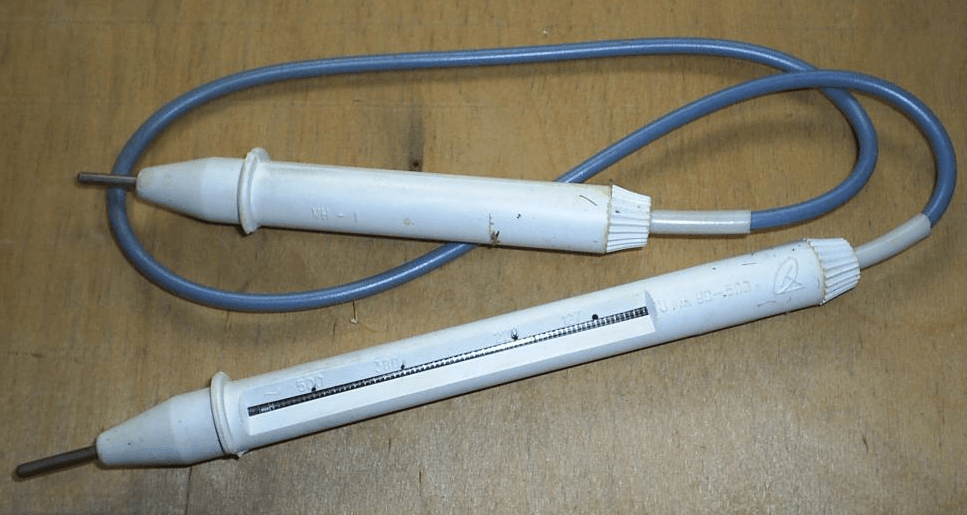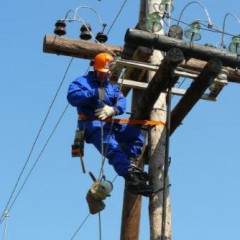What are voltage indicators?
Types of devices
Pointers up to 1000 volts and above 1000 volts have different external and design features. For low-voltage measurements, up to 1 kV, there are two types of devices:
- unipolar, reacting to the flow of capacitive current;
- bipolar, gives an indication when an active current flows through it.
The single-pole indicator is designed to work in alternating current circuits, for detecting a phase conductor, in lighting circuits, during phasing of an electric meter, and for checking lampholders. Simply put to detect live wires.
Single-pole phase indication devices have the same design and, as a rule, consist of a gas discharge indicator lamp, with an ignition threshold from 90 to 120 volts and a resistor per 1 MΩ resistor connected in series. The resistor limits the current to a safe value of the order of 0.5 mA.
The IN-90 indicator is made in the form of a screwdriver.
The disadvantages of such indicators include low sensitivity (the indication threshold of some devices starts at 90 volts), as well as sensitivity to pickups in adjacent wires.
For networks above 1000 volts, voltage indicators are made with handles made of insulating material and long, excluding the proximity of a person to current-carrying elements. The exterior of UVN-10 is shown in the photo below:
When measuring voltages above 1000 volts, resort to the use of additional protective equipment: rubber gloves, bots or an insulating mat. Discover, what electrical protective devices are used in installations above 1000 voltsYou can from our article!
The bipolar pointer consists of two cases of insulating material and a flexible copper conductor in insulation that connects them. Diagram of a bipolar voltage indicator type UNN-10:
In this circuit, a gas discharge indicator is shunted by a resistor, which makes the circuit insensitive to induced voltages. Also on its basis an indicator is issued with an indication of the voltage value UN-1:
This device uses a special linear gas discharge lamp and a scale on the housing with a graduation of 127, 220, 380, 500 Volts.
There are also universal voltage indicators for phase and zero definitions, checking the presence of voltage and indicating its value from 12 to 380 V. For operation in DC, up to 500 volts and alternating current circuits, up to 380 volts. They can be additionally used for continuity calls.
In these devices, LEDs are used as light indicators, and a large capacitor as a power source.
The digital voltage gauge has an LCD display with volts. At a maximum value of 220 volts, all values from minimum to maximum shine on the screen. Those. This tester shows an approximate value. The only plus of this model is the lack of a power source.
Contactless indicators are designed to detect live conductors, including those hidden in walls or panels. The circuit of this device responds to an alternating electromagnetic field, is equipped with a light and sound indication. We talked about these devices more when we talked about how to find wiring in the wall.
Terms of use
Before using the voltage indicator, make sure that it is in good condition. To do this, in a known working network, you need to check the indication of the device. Only after a positive result is it allowed to use it.
It is forbidden to use an incandescent lamp as an indicator, due to its low reliability and high risk of injury. When searching for the phase, it is necessary to install the pointer probe on the conductor of interest, hold the device in the right hand, hide the left hand behind the back, and touch the end contact with the thumb of the right hand. This is for a single pole indicator.
For a two-pole probe with an indicator, put it on the wire or terminal of interest, and the second probe on zero or the adjacent phase. As you can see, there is nothing complicated in working with these devices. Remember the dangers of working under stress and observe personal safety precautions.
Finally, we recommend watching a video in which the specialist reviewed the existing types of voltage indicators and the rules for using these devices:
So we examined the types, purpose and rules for using the voltage indicator. We hope the information provided was informative and useful for you!
It will be interesting to read:













